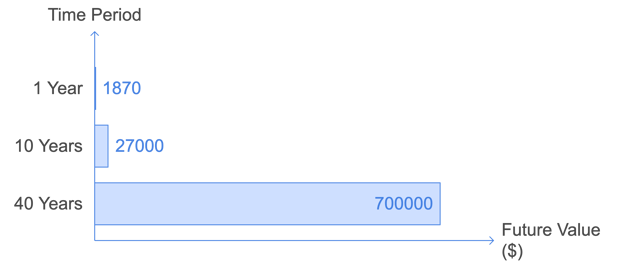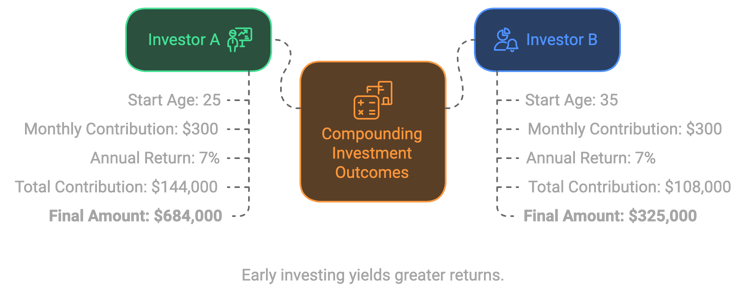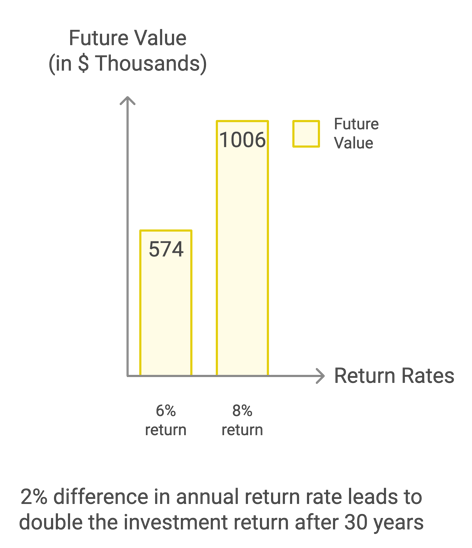Skip the Latte, retire rich: the millionaire’s secret of compounding
Have you ever heard of the phrase, “Money makes money”? Well, if you want to retire rich, when it comes to investing this couldn't be more accurate. The secret behind this phenomenon is called Compounding. This simple yet powerful concept is what can turn even small, consistent investments
MONEYFINANCIAL FREEDOMINVESTMENTS
Asaf Hacmon
10/14/20246 min read


Time is your best friend
Let’s get one thing straight—compounding works best when you give it time. The longer your money is invested, the more dramatic the growth. If you give compounding 30, 40, or 50 years to work, your initial investment can grow exponentially. It’s this long-term horizon that separates successful investors from those who get caught up in short-term gains.
Now, let's dive into some compelling examples to illustrate how powerful compounding can be!
The $1 million coffee example
We all have our guilty pleasures. For many, it’s the daily coffee fix. But what if I told you that skipping your morning latte could make you a millionaire?
Here’s the math: Imagine you spend $5 every day on coffee. If you decided to invest that $5 a day instead in a stock market index fund that returns an average of 8% per year, compounded monthly, you'd be on the path to serious wealth. Let’s break it down:
After just 1 year, you’d have around $1,870.
After 10 years, you’d have over $27,000.
After 40 years, that $5 daily investment would balloon to over $700,000.
Takeaway: Small changes can lead to big rewards. Skipping one small expense daily can lead to a financial future most people only dream of.
The power of early investing: why your future self will thank you
Let’s say you’re in your 20s or 30s right now, and you're wondering if investing makes a difference. The answer is a resounding yes! The earlier you start, the more time compounding can work its magic. To illustrate this, let's compare two hypothetical investors: Investor A and Investor B.
Investor A starts at age 25. They contribute $300 per month to an investment account that grows at an average rate of 7% per year until age 65. By the time they retire, they would have contributed a total of $144,000, but the power of compounding turns that into a whopping $684,000.
Investor B waits until age 35 to start. They also contribute $300 per month at the same 7% return, but by the time they reach 65, they’ve only contributed $108,000. As a result, their investment grows to just $325,000—less than half of what Investor A earned.
Why is there such a big difference? Because Investor A gave compounding an extra 10 years to do its thing. Even though both invested the same amount each month, time is what tipped the scales in Investor A’s favor.
Takeaway: Start early! Enough time makes even small amounts of money grow into significant sums.
The rule of 72: how fast will your money double?
Wouldn’t it be great to know how long it takes for your investment to double? With the Rule of 72, you can do just that. It’s a quick mental math trick to estimate how long it will take your money to double at a given annual interest rate. Here’s how it works:
Take the number 72 and divide it by your annual return percentage. The result tells you roughly how many years it will take for your investment to double. For example:
At a 6% return, your money will double in 12 years (72 ÷ 6 = 12).
At a 10% return, your money will double in just 7.2 years (72 ÷ 10 = 7.2).
This rule helps you visualize how powerful even slight changes in interest rates can be over time. For instance, if you invest $10,000 at a 10% return, you’ll have $20,000 in just over 7 years, and by 14 years, that same investment will grow to $40,000.
Takeaway: Use the Rule of 72 to see how different interest rates affect your investment’s growth. The faster your money doubles, the more exponential your returns will be.
Warren Buffett: the compounding king
When people think of long-term investing, one name always comes up: Warren Buffett. Known as one of the greatest investors of all time, Buffett has built a fortune almost entirely thanks to the power of compounding.
Here’s an interesting fact: 99% of Buffett's wealth was accumulated after his 50th birthday. While most people might think they’re too late to start investing, Buffett’s story shows that time—and patience—are the ultimate wealth builders.
At age 30, Buffett had a 'modest' fortune of $1 million.
By age 60, that had grown to $1 billion.
Today, in his 90s, Buffett is worth more than $100 billion!
Buffett didn’t make his fortune overnight. He allowed compounding to work steadily over decades, reinvesting his returns rather than cashing them out. His wealth is a testament to how compounding over time can transform ordinary investments into extraordinary wealth.
Takeaway: Like Warren Buffett, the secret to long-term wealth is to keep reinvesting your returns and let compounding do the heavy lifting.
The difference between 6% and 8%: why even small percentages matter
Let’s look at how small changes in your return rate can have massive consequences when compounded over time. Let’s say you invest $100,000 today:
At a 6% return, in 30 years, your investment will grow to $574,000.
At an 8% return, in 30 years, that same investment will grow to $1,006,000.
Just a 2% difference in annual returns can mean a difference of over $400,000 after 30 years! This shows that paying attention to your returns—whether by choosing low-fee investments or selecting more growth-oriented assets—can significantly impact your future wealth.
Takeaway: Small improvements in returns, even by just 1% or 2%, can lead to big financial differences over time. Always aim for the best return while balancing risk.


What is compounding?
Compounding is like planting a money tree, but instead of just watching it grow, the fruit it produces (interest or returns) is constantly replanted, leading to more trees and fruit! Compounding means earning returns on your initial investment and the returns it generates over time. This creates a snowball effect, where your investment gains momentum over time. The longer you let compounding work, the more powerful it becomes. It's the closest thing to "free money" in the world of finance, but there's one critical ingredient: time.
Imagine being offered 2 options: One is to receive $1,000,000 today. The second option is to receive 1 cent today but have it doubled every day for 30 days. Which option would you choose? Curious how the second option adds up over 30 days?






Conclusion: start your journey now.
The magic of compounding is available to everyone, but the key is to start as soon as possible and give your investments time to grow. Whether it’s skipping a daily coffee or setting up automatic contributions to an investment account, every little bit helps. The sooner you start, the greater your reward down the road.
Remember, the magic isn’t in how much you invest, but in how long you let your money work for you. So start planting your money tree today, and watch it grow into a forest tomorrow!
How you can leverage compounding today
So, how can you take advantage of the magic of compounding in your life? Here are a few actionable tips:
Start early: The earlier you invest, the more time compounding has to work.
Be consistent: Even small, regular investments grow substantially over time.
Reinvest: Let your returns generate more returns—don’t cash out early.
Choose growth: Higher returns lead to bigger gains. Look for investments that match your risk tolerance but aim for solid growth.
Be patient: Compounding works best when you give it time. Don't get discouraged by short-term market fluctuations.
Contact me
+351 926 915 570
asaf@blueskycoach.me


My office
Lagos (Algarve) Portugal
